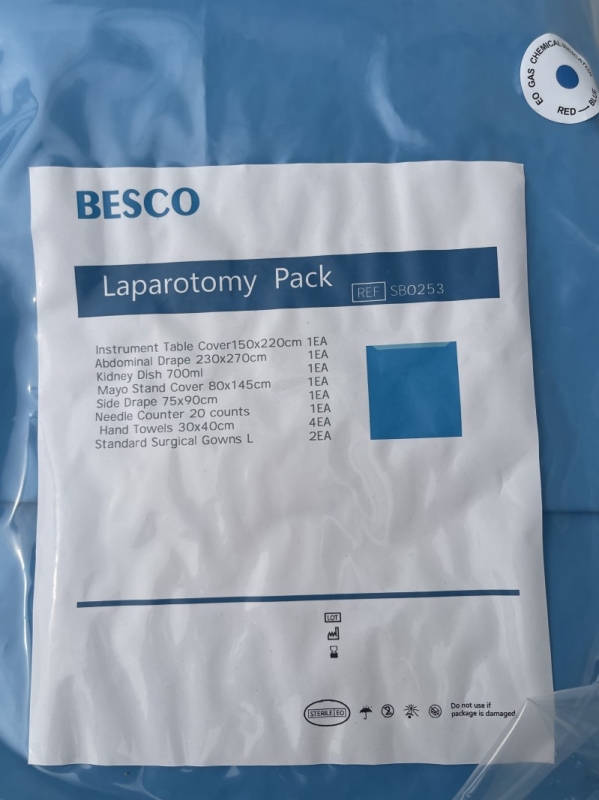laparotomy packs

A laparotomy pack is a sterile, pre-packaged set of supplies for abdominal surgery, which typically includes a large "T" drape with a fenestration (opening) for the surgical site, a back table cover, a Mayo stand cover, a suture bag, hand towels, and sometimes surgical gowns and instrument pads. These packs are designed to increase clinical efficiency and maintain sterile conditions during a laparotomy, a surgical procedure to access the abdominal cavity.
Key components of a laparotomy pack
Laparotomy drape: A large, sterile drape specifically designed for abdominal surgery. It often features an absorbent reinforcement, a fenestration with adhesive to secure it around the incision, and a built-in instrument pad.
Back table cover: A large, sterile cover for the back table where surgical instruments are organized.
Mayo stand cover: A sterile cover for the Mayo stand, a portable instrument table used during surgery.
Suture bag: A sterile bag for holding sutures and other small disposable items during the procedure.
Hand towels: Sterile towels for the surgical team to dry their hands.
Surgical gowns: Some packs may include sterile surgical gowns for the medical staff.
Utility drapes: Smaller drapes used to manage cords or create a sterile field around the surgical site.
Usage examples
Standard laparotomy: The pack provides all the necessary sterile components for a routine abdominal surgery, ensuring a clean and organized surgical field.
Damage control surgery: In trauma cases, a laparotomy pack can be used in a "damage control" approach, where the abdomen is temporarily packed and closed to stabilize the patient, with the goal of a second operation once the patient is more stable.
Other abdominal procedures: Packs can also be adapted for other abdominal procedures like laparoscopy, with specific packs designed for that purpose.

To use a laparotomy pack, first, check the pack for any damage or expired dates. Then, place the pack on a sterile surface and open it by unfolding the corners one at a time, making sure not to touch the contents with unsterile hands. Finally, use the contents as needed for the surgical procedure, such as draping the patient or using the included instruments, while maintaining sterile technique.
Step 1: Check and prepare the pack
Verify sterility: Inspect the packaging for any rips, stains, or moisture. Check that the expiration date is valid and that the sterilization indicator tape has changed color.
Position the pack: Place the pack on a clean, dry, and stable surface like a back table. Ensure the outer flap is facing the person opening it.
Step 2: Open the pack aseptically
Remove the outer layer: Break the seal or tear the tape without touching the inside of the pack. Remove or tear the tape without contaminating the package.
Unfold the corners:
Use your unsterile fingers to grasp the outer edge or corner of the first fold. Pull it away from the pack, moving around the table as needed to avoid reaching over the sterile field.
Unfold the remaining corners one at a time, being careful not to touch the sterile contents inside.
Avoid tugging on the drape, as this can cause contamination.
Deposit the contents: Once open, deposit the sterile contents onto the sterile field. Step back without turning your back to the sterile field to allow the next person to complete the process.
Step 3: Use the contents
Drape the patient: Position the drapes around the surgical site according to the procedure's requirements. Many packs include drapes with adhesive strips to secure them in place.
Set up instruments: Arrange the instruments from the pack on the sterile field. Remember to use sterile gloves and surgical attire throughout the procedure.
Manage the field: Use any additional features, such as the Velcro tabs, to secure cords or tubing.
Place the laparotomy pads: If using laparotomy pads during the procedure, place them in the abdominal cavity to protect the organs and absorb blood.

 Send Email
Send Email